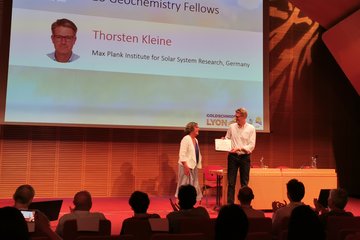Alle Typen
561.
Zeitschriftenartikel
Variations of solar spectal irradiance from near UV to the infrared - measurements and results. Journal of Atmospheric and Solar-Terrestrial Physics 63, S. 1479 - 1487 (2001)
562.
Zeitschriftenartikel
Empirical models of solar magnetic flux-tubes and their non-magnetic surroundings. Astronomy and Astrophysics 369, S. 646 - 659 (2001)
563.
Zeitschriftenartikel
A formation mechanism of magnetic elements in regions of mixed polarity. Solar Physics 203, S. 1 - 7 (2001)
564.
Zeitschriftenartikel
Large Doppler shifts in X-ray plasma: An explosive start to coronal mass ejection. Astrophysical Journal 549, S. L249 - L252 (2001)
565.
Zeitschriftenartikel
The influence of an inclined rotation axis on solar irradiance variations. Astronomy and Astrophysics 376, S. 1080 - 1089 (2001)
566.
Zeitschriftenartikel
Intercalibration of SUMER and CDS on SOHO. II. SUMER A and B detectors and CDS NIS. Applied Optics 40, S. 6292 - 6300 (2001)
567.
Zeitschriftenartikel
Comparison of quiet-Sun radiances measured by CDS and SUMER on SOHO. Space Science Reviews 97, S. 63 - 66 (2001)
568.
Zeitschriftenartikel
High-resolution solar polarimetry with Sunrise. Astron. Nachrichten 322, S. 363 - 366 (2001)
569.
Zeitschriftenartikel
High-resolution solar polarimetry with SUNRISE. Astron. Ges. Abstract Ser. 18, S. 1001 (2001)
570.
Zeitschriftenartikel
Noise reduction in helioseismic power spectra by non-orthogonal wavelets. Astronomy and Astrophysics 379, S. 1039 - 1044 (2001)
571.
Zeitschriftenartikel
Successful spectral synthesis of Zeeman-split molecular bands in sunspot spectra. Astronomy and Astrophysics 364, S. L101 - L104 (2000)
572.
Zeitschriftenartikel
EUV brightness variations in the quiet Sun. Astronomy and Astrophysics 353, S. 1083 - 1093 (2000)
573.
Zeitschriftenartikel
The solar spectral irradiance since 1700. Geophysical Research Letters 27, S. 2157 - 2160 (2000)
574.
Zeitschriftenartikel
Properties of flux tubes and the relation with solar irradiance variability. J. Astrophys. Astron. 21, S. 275 - 282 (2000)
575.
Zeitschriftenartikel
Modelling irradiance variations from the surface distribution of the solar magnetic field. Astronomy and Astrophysics 353, S. 380 - 388 (2000)
576.
Zeitschriftenartikel
Modelling short-term spectral irradiance variations. Space Science Reviews 94, S. 139 - 144 (2000)
577.
Zeitschriftenartikel
Properties of the solar granulation obtained from the inversion of low spatial resolution spectra. Astronomy and Astrophysics 358, S. 1109 - 1121 (2000)
578.
Zeitschriftenartikel
Size-dependent properties of simulated 2-D solar granulation. Astronomy and Astrophysics, Suppl. Ser. 146, S. 267 - 291 (2000)
579.
Zeitschriftenartikel
Spin and orbital angular momentum exchange in binary star systems. II. Ascending the giant branch: a new path to FK Comae stars. Astronomy and Astrophysics 359, S. 552 - 562 (2000)
580.
Zeitschriftenartikel
Spin and orbital angular momentum exchange in binary star systems. II. Ascending the giant branch: a new path to FK Comae stars. Astronomy and Astrophysics 359, S. 552 - 562 (2000)











